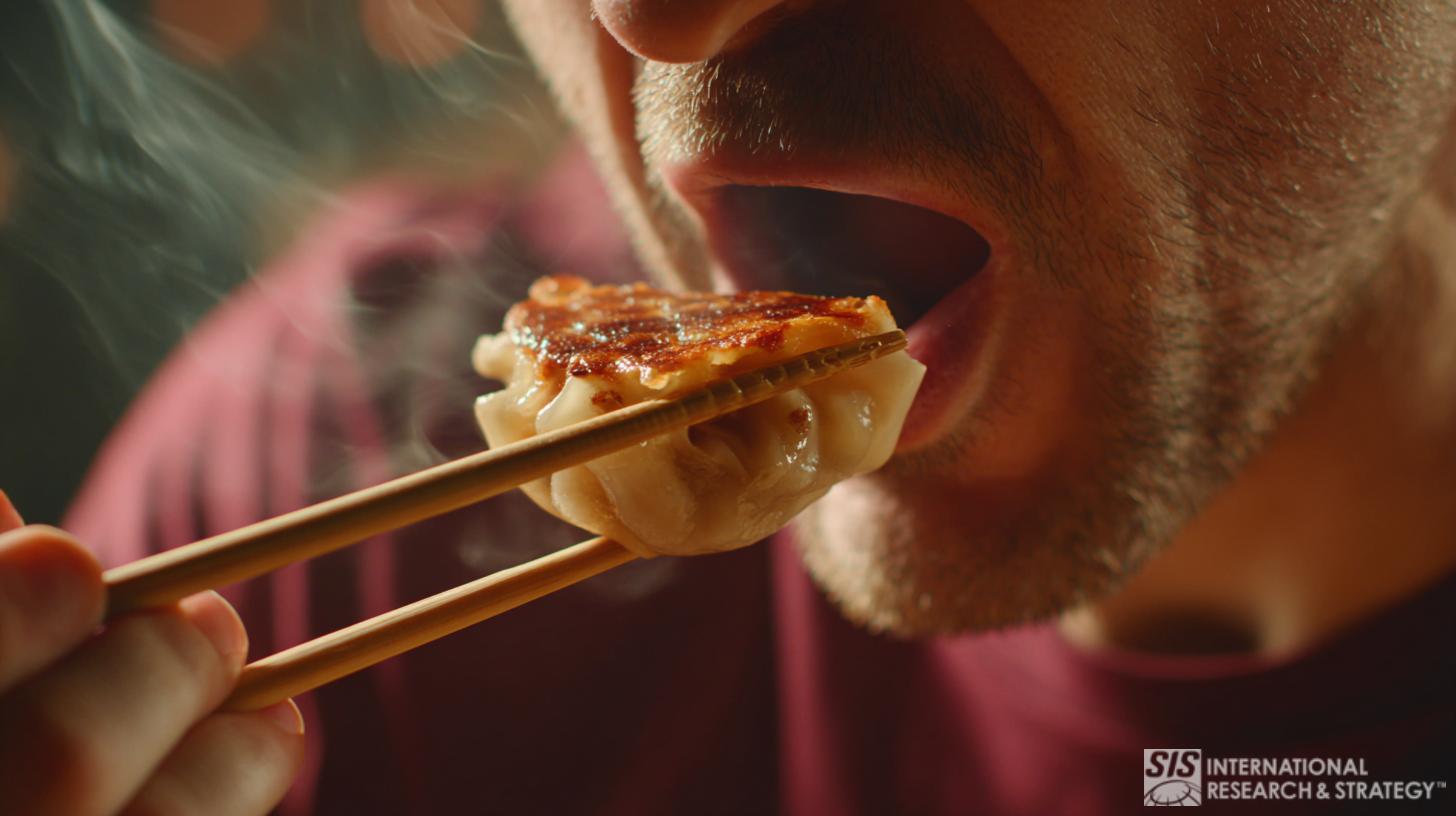Badania rynku testów reakcji smakowej

In culinary exploration, taste is the key to unlocking consumer satisfaction and market success… But, how can businesses ensure that their products tantalize taste buds and capture hearts? This question lies at the core of the taste response test, a powerful market research tool that reveals the sensory experiences driving consumer preferences.
Table of Contents
Czym jest badanie rynku testów reakcji smakowej?
Taste response test market research evaluates and analyzes consumer responses to food and beverage products based on taste perception. Unlike traditional market research methods that rely on surveys or focus groups, taste response tests involve direct sensory evaluation, allowing researchers to measure consumers’ immediate reactions to various flavors, textures, and aromas.
During a taste response test, participants are presented with samples of food or beverage products and asked to provide feedback on factors such as taste intensity, flavor profile, mouthfeel, and overall liking.
Dlaczego firmy potrzebują badań rynku w zakresie testów reakcji na smak?
By understanding consumers’ taste preferences and sensory perceptions, businesses can develop products perfectly aligned with market demand. Taste response tests provide precise insights into flavor profiles, texture preferences, and overall liking, enabling enterprises to fine-tune product formulations and create offerings that resonate with consumers’ palates.
Moreover, taste response test market research allows businesses to identify unique flavor profiles, innovative ingredient combinations, and sensory experiences that set their products apart.
Ponadto badania rynku testujące reakcje smakowe umożliwiają firmom opracowywanie produktów, które stale spełniają lub przekraczają oczekiwania konsumentów, wzmacniając reputację marki i wspierając pozytywne rekomendacje z ust do ust. Jednak te badania rynku oferują firmom wiele korzyści, dostarczając praktycznych spostrzeżeń i napędzając strategiczne wyniki, w tym:
- Dokładne informacje o konsumentach: Taste response tests provide market research with accurate, objective insights into consumer taste preferences and sensory perceptions.
- Zoptymalizowane formuły produktów: Dzięki danym z testów reakcji smakowej firmy mogą optymalizować składy produktów, aby spełnić preferencje konsumentów i zapotrzebowanie rynku.
- Wczesne wykrywanie trendów rynkowych: Badania rynku pozwalają firmom identyfikować pojawiające się trendy smakowe i preferencje smakowe zanim staną się one powszechne.
- Ekonomiczny rozwój produktu: Przeprowadzenie testów reakcji smakowej na wczesnym etapie rozwoju produktu może pomóc firmom uniknąć kosztownych błędów i późniejszych iteracji.
- Udoskonalone strategie marketingowe i brandingowe: Produkty, które niezmiennie dostarczają wyjątkowych doznań smakowych, mogą być skutecznym narzędziem marketingowym, budującym lojalność wobec marki i jej promocję.
Sensory Testing Methodologies and Industry Standards
| Testing Method | Panel Size | Purpose & Application | Source |
|---|---|---|---|
| Hedonic Testing | 75-150 consumers | Measures consumer preference and product liking using structured scales to evaluate overall acceptance | ScienceDirect Topics |
| Expert Descriptive Analysis | 8-12 trained assessors | Provides objective sensory characterization of product attributes with highly trained panelists who perform detailed evaluations | Nofima Research Institute |
| Consumer Location Testing | 80-100 participants | Ensures statistical significance for quantitative consumer preference data in real-world or controlled environments | Highlight Consumer Testing |
| Quantitative Descriptive Analysis (QDA) | 10-12 trained panelists | Industry-standard methodology for detailed sensory profiling using consensus vocabulary and intensity scales | Quirks Research Guide |
| Check-All-That-Apply (CATA) | 50+ consumers | Rapid sensory evaluation method allowing consumers to identify multiple applicable attributes efficiently | National Library of Medicine |
| Discrimination Testing | 30-50 panelists | Determines whether perceptible sensory differences exist between products using triangle or paired comparison tests | ScienceDirect Topics |
| Just-About-Right (JAR) Scales | 75-150 consumers | Evaluates product attributes like sweetness, acidity, and texture to optimize formulations based on ideal intensity levels | ScienceDirect Topics |
| Threshold Testing | 15-30 assessors | Determines the minimum concentration at which a sensory stimulus becomes detectable to consumers | ASTM International Standards |
Oczekiwane wyniki badań rynku testów reakcji smakowej SIS

SIS International Research oferuje kompleksowe usługi badań rynku testów reakcji smakowych, aby zapewnić klientom praktyczne spostrzeżenia i napędzać strategiczne wyniki. Oto niektóre oczekiwane rezultaty współpracy z SIS:
- Szczegółowa analiza sensoryczna: SIS conducts detailed sensory analysis to provide clients with a deep understanding of taste preferences, flavor profiles, and sensory perceptions among target consumers.
- Opinie i spostrzeżenia konsumentów: SIS gathers direct consumer feedback through taste response tests, providing clients with valuable insights into consumer preferences, product acceptance, and areas for improvement. SIS helps clients identify strengths, weaknesses, and opportunities for improvement, guiding strategic decision-making and product development.
- Analiza porównawcza konkurencji: SIS conducts competitive benchmarking as part of taste response test market research, enabling clients to compare their products with competitors and identify areas for differentiation.
- Rekomendacje strategiczne: SIS delivers strategic recommendations based on data-driven insights and sensory analysis, empowering clients to make informed decisions and drive business growth.
Technologie i narzędzia wykorzystywane w tym badaniu rynku
W nowoczesnym krajobrazie badań rynku testów reakcji na smak, zaawansowane technologie i innowacyjne narzędzia są kluczowe w ulepszaniu gromadzenia, analizy i interpretacji danych. Oto niektóre technologie i narzędzia wykorzystywane w badaniach rynku testów reakcji na smak:
- Oprogramowanie do oceny sensorycznej: Specialized platforms streamline data collection and analysis during taste response tests. These software solutions allow researchers to design experiments, record sensory evaluations, and analyze results efficiently. Examples include Compusense, FIZZ Software, and EyeQuestion.
- Elektroniczne urządzenia do badania języka i nosa: Electronic tongue and nose devices mimic human taste and olfactory sensations, enabling researchers to objectively assess flavor profiles, aroma compounds, and overall taste perceptions.
- Rzeczywistość wirtualna (VR) i rzeczywistość rozszerzona (AR): VR and AR technologies enable researchers to create immersive sensory experiences for participants during taste response tests.
- Czujniki biometryczne: Biometric sensors, such as electroencephalography (EEG), galvanic skin response (GSR), and heart rate monitors, measure physiological responses to taste stimuli, providing researchers with additional data points beyond subjective evaluations.
Możliwości na rynku testów reakcji smakowej

Rynek testów reakcji smakowych oferuje wiele możliwości dla firm, które chcą wprowadzać innowacje, wyróżniać się i odnosić sukcesy w branży spożywczej i napojów. Oto kilka kluczowych możliwości:
- Innowacja produktowa: Testy reakcji smakowej dostarczają przedsiębiorstwom informacji na temat pojawiających się trendów smakowych, preferencji smakowych i percepcji sensorycznych, umożliwiając im tworzenie innowacyjnych produktów, które znajdą uznanie u konsumentów.
- Ekspansja rynkowa: Testy reakcji na smak mogą pomóc przedsiębiorstwom identyfikować możliwości ekspansji i dywersyfikacji rynku poprzez eksplorację nowych preferencji smakowych i segmentów konsumentów.
- Różnicowanie marki: Produkty zapewniające wyjątkowe doznania smakowe mogą stać się silnym wyróżnikiem marki, odróżniając ją od konkurencji i budując lojalność wobec marki.
- Zaangażowanie konsumenta: Taste response tests enable businesses to interact directly with consumers, gather feedback, and foster a sense of involvement and ownership in product development.
Distribution of Sensory Testing Methodologies in Industry Research
Source: Based on data from National Library of Medicine – Trends in Food Sensory Evaluation
W jaki sposób badania rynku testów reakcji smakowej firmy SIS International pomagają firmom
SIS Międzynarodowy offers specialized taste response test market research services to provide businesses with actionable insights and drive strategic outcomes in the food and beverage industry. Here's how SIS's expertise can benefit businesses:
- Indywidualne podejście badawcze: SIS tailors its research to each client's unique needs and objectives. SIS designs taste response tests that deliver targeted insights and actionable recommendations, ensuring maximum value and impact for businesses launching new products, optimizing existing formulations, and entering new markets.
- Zaawansowana analiza sensoryczna: SIS conducts advanced sensory analysis to provide clients with in-depth insights into taste preferences, flavor profiles, and sensory perceptions among target consumers.
- Globalny zasięg i wiedza specjalistyczna: With a worldwide network of experienced researchers and sensory experts, SIS offers businesses access to insights from diverse markets and regions worldwide.
- Długoterminowe partnerstwo: Our experts foster long-term partnerships with clients, serving as trusted advisors and strategic partners in their journey toward success.
Lokalizacja naszego obiektu w Nowym Jorku
11 E 22nd Street, piętro 2, Nowy Jork, NY 10010 T: +1(212) 505-6805
O firmie SIS International
SIS Międzynarodowy oferuje badania ilościowe, jakościowe i strategiczne. Dostarczamy dane, narzędzia, strategie, raporty i spostrzeżenia do podejmowania decyzji. Prowadzimy również wywiady, ankiety, grupy fokusowe i inne metody i podejścia do badań rynku. Skontaktuj się z nami dla Twojego kolejnego projektu badania rynku.

